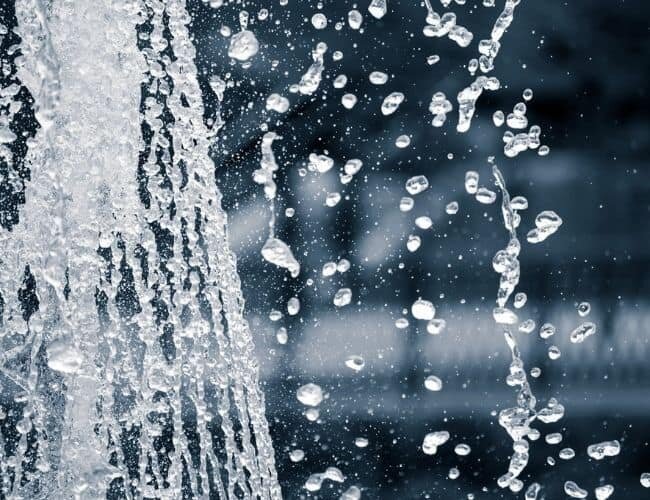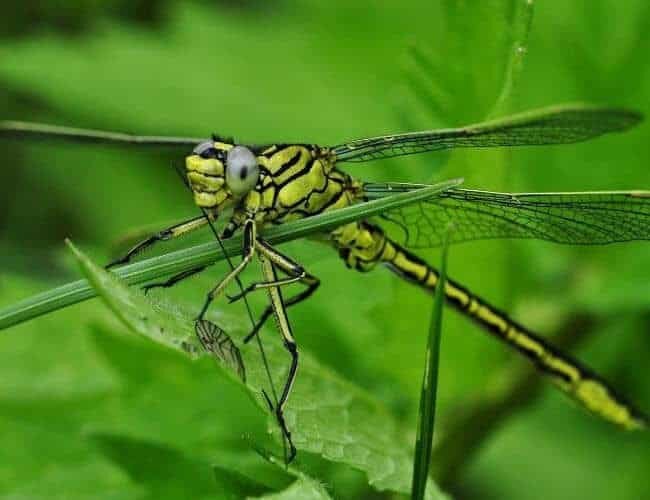The Hows and Whys of Inviting Dragonflies into your Garden
Dragonflies are second only to hummingbirds (at least in my mind) in their entertainment value and aerial acrobatics. I love working in the garden and watching them dive and swoop amongst the flowers as they relish the warm sunshine.
But, what’s the best way to bring dragonflies into your yard, and aside from their entertainment value, why would you want to?
We’ll get to the why of wanting dragonflies in a minute. First, let’s talk about HOW to get them into your garden.
Water: Your #1 Tool for Attracting Dragonflies

A large portion of a dragonfly’s life is spent underwater, as a nymph or juvenile. In fact, for some species, life underwater goes on for several years, with the adults emerging for only a few weeks before dying. Others live up to a year as adults and only exist as nymphs for a couple of months.
For this reason, if you happen to have a backyard pond or water garden, you likely have a fair amount of dragonflies flitting around. If you don’t, why not consider putting in a water feature?
This post contains affiliate links. When you make a purchase through one of these links, I receive a small commission. This does not affect your purchase price.
Are you ready for Amazon Prime Days coming up July 15-16, 2019? If you’re not a Prime member yet, you can get a FREE 30-day membership so you can take advantage of the amazing deals! Did you know there are deals every day leading up to Prime days as well? I’m updating you on the best deals every day now through Prime days here, come on over and check them out!
What Kind of Pond do I Need?
You don’t need a huge pond in order to have dragonflies. Anything at least 2 feet deep will work. There are lots of preformed pond liners available for a very reasonable price. Here are some options to get you started.
At our old house, we got one of these liners and created a small water garden. It cost a total of maybe $150 to get started because we didn’t buy a kit (although I think the kits are cheaper) plus one afternoon of digging, leveling, etc. to get it placed, and a little more time to get plants installed around and in it to my satisfaction.

if you put in a water feature
Our very small pond attracted all manner of critters, from frogs to dragonflies to even a few snakes! It was easy to maintain once I got algae control figured out (barley straw will be your very best friend!).
Because we live where it gets below freezing in the winter, we added a pond heater during cold weather to maintain a small hole in the ice for the water plants and any small creatures who might have been overwintering in the pond as well.
Note: Nonhardy plants like water lilies can often be allowed to overwinter in the bottom of your pond, as long as there’s a hole in the ice to allow for oxygen intake.
I did empty and clean the pond once every couple years in early spring to get the sediment and old leaves off the bottom, but that was pretty much it. Because we had a bubbler in it, mosquito larvae weren’t a problem, and it was so nice to sit out on warm evenings and listen to the sound of running water.
I even raised a few bullfrog tadpoles one year, which was really cool. However, if you’re trying to attract dragonflies, this wouldn’t be recommended, as the bullfrogs will eat the dragonfly nymphs.
Pro tip: If you’re trying to attract dragonflies (or even frogs), DO NOT put fish in your pond. They WILL eat everything they can get their little fishy mouths around, including frog eggs and dragonfly nymphs. Plus, fish are quite a bit of work, so if you’re looking for easy-care, nix the fish.
Although we don’t yet have a pond at our new property (it’s on the bucket list as we want a large one this time!), there happens to be a natural one just next door, so we have an abundance of dragonflies in our garden.
We do have what I call my “mud puddle” (you may have seen it on Instagram a couple of weeks back, and I’ve included a pic below). We decided to put it on the patio this year instead of out farther in the garden so we could enjoy it more.

In addition, I also added a small solar fountain to it (like this one). Just a note that the fountain only works when the sun is shining directly on the solar panel, it doesn’t have a battery to store energy for when the sun isn’t shining.
While I was sitting on the patio writing this post, a dragonfly swooped in to investigate the fountain in my mud puddle! Even without a true pond, the sound of running water attracted the little guy.
So even if you don’t have a pond, why not put in a small fountain? The sound will entice any passing dragonflies to drop in and pay a visit.

Let’s say a pond or fountain isn’t an option for you, what else can you do to attract dragonflies?
Plants for Dragonflies
Plants for dragonflies is probably something of a misnomer. You’re not really planting certain varieties for dragonflies as much as planting them for the insects that will become the dragonfly’s next meal!
Because dragonflies like to perch and survey their surroundings, any tall plant they can perch on will encourage them to stay around. Funny enough, I even notice them perching on top of some of my taller lawn ornaments!

Any type of plant that attracts small insects to your garden is also great. Joe Pye weed (Eutrochium spp), swamp milkweed (Asclepias incarnata) or Black-eyed Susans (Rudbeckia hirta) come to mind. I also notice them spending a fair amount of time on my butterfly weed (Asclepias tuberosa).
These plants are all ideally suited to my climate in Zone 6b. This is wonderful, but does bring up one point I’d like to make: Planting anything native that attracts pollinators typically means planting varieties that are going to spread in your garden. If you don’t want that, you’ll have to work a bit harder to find varieties that won’t be quite as prolific or you’ll have to get REALLY good at deadheading!
Do some research on native pollinator plants in your area and you should get all the information you need to make a good choice for your climate. And yes, the dragonflies will eat a few of your beneficial pollinators, but they’ll eat a whole lot more than that.
More on that in a minute….

If you do happen to have a pond or water source, be sure to stock it with lots of plants as well. Water lilies are a great choice to help shade the pond (which will work to keep algae down as well), and give your dragonfly nymphs a place to hide from predators. In fact, an abundance of underwater plants will give dragonfly young the best chance at a long and healthy life.
Once dragonflies are ready to begin life as adults, they must climb out of the water to dry off and open their wings. For this reason, planting some vertical plants along the edge of your pond is helpful. Plants like water iris or certain kinds of rush can be a good choice.
Pro tip: Just a note that some types of iris and rush can be invasive in some parts of the country. Be sure to check with your local county extension agency before planting anything questionable. And please, please, PLEASE DO NOT plant purple loosestrife! It is terribly invasive in North America (more about that here).
Why Do I Want to Attract Dragonflies?
In a word: MOSQUITOES! A single dragonfly can eat hundreds of mosquitoes a day. They also eat flies, gnats, ants, and termites.
Of course, they can and will occasionally eat bees and butterflies, but this certainly doesn’t mean they’re bad or undesirable in the garden. The good they do eating mosquitoes and ants certainly outweighs any bad they might do in the average home garden.
Even the nymphs are voracious eaters, and will happily gobble down loads of mosquito larvae underwater. Talk about a win-win! (at least for those of us who seem to be food of the gods to most biting insects. *sigh*).
Fun Dragonfly Facts
I thought I’d leave you with two fun dragonfly facts you can wow guests with at your next dinner party.

First, fossilized dragonflies have been found with wingspans of up to 2 1/2 feet! Can you imagine one of them buzzing you at your next picnic??
Second, although a dragonfly may try to bite you if you catch him, only the very largest (maybe those fossilized ones!) can even hope to break your skin, and that’s very rare. In fact, some authorities assert that they can’t bite, while others say they may break the skin, but only if they feel threatened and can’t get away.
Despite their somewhat fierce appearance and reputation, dragonflies are no danger to humans or pets, just the many insect pests they love to devour. If you should be lucky enough to have one land on you, admire him, talk to him and enjoy him, but don’t fear him. He’ll fly off in his own time and neither of you will be any the worse for wear.

I hope you’ve enjoyed my post today and that you’ve learned a few things about dragonflies. I’d love to hear from you if I’ve inspired you to add a water feature to your garden to attract them. There are a few pinnable images below, please be sure to pin one so you can find me later!
This post was shared on the Farm Fresh Tuesday blog hop.
As always, smile and have a crazy organic day.
Posts Related to Attracting Dragonflies
- Resource Library
- Amazon Prime Days are coming!
- Shrubs to Attract Pollinators
- Hummingbirds in the Garden
- Spring Garden Tour
- Favorite Flowering Plants, Part 1
- Favorite Flowering Plants, Part 2
- The Ultimate Gardening Journal




4 comments
I am happy I read your article. I am a first time gardener in Mozambique and after starting a small flower and vegetable garden I started seeing 4 different types of butterflies, local African bees and dragon flies. I did not know whether dragonflies meant havoc to my garden or not and what to do with them so your article really helped.
PS: I apologise if I misspelled any word as I am not very fluent in this language.
I’m glad you enjoyed the article. I didn’t realize you had dragonflies in Mozambique, but since I bet you have mosquitoes too, be thankful for your dragonflies!
I am fascinated by the colors of dragonflies and damselflies! They are so pretty. A couple of years ago we happened to be outside at dusk and we were dive bombed by a swarm of dragonflies!
🙂 gwingal
That must have been kind of cool (and maybe just slightly terrifying!)